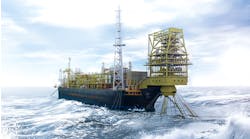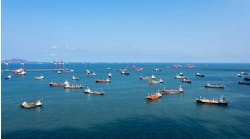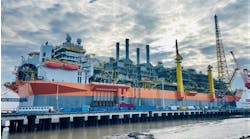Deepwater construction projects are providing a steady workload for Mærsk Supply Service. "Over the past five years we have added a continuous flow of newbuildings," says a Mærsk spokesman. "Our strategy is to focus increasingly on deepwater. Most of our fleet of 60 vessels are suited to this sector."
In June 2003, the company took delivery of the Mærsk Winner from the Volkswerft Stralsund yard in eastern Germany. This was a speculatively built, A-class craned anchor-handler. Features include a 200-tonne heave-compensated Kenz crane, rated for operations in up to 2,000 m of water, and a centrally located 5.2 m x 4.38 m moonpool, accessible from the main deck. The moonpool is also equipped with a splash damping system that limits the impact of waves and water splashing during deployment of modules such as wellheads or hydraulic items.
null
According to the spokesman, the vessel has already worked for all major operators in the Gulf of Guinea, from Gabon to Côte d'Ivoire. One job involved module lifts through the moonpool in 800 m of water for repair and maintenance associated with the Ceiba development off Equatorial Guinea. Mærsk Winner has also undertaken well stimulation on various production platforms for Total Nigeria. During the construction phase the vessel's accommodation was increased from 56 to 86 bed spaces.
Currently, Mærsk is building four new offshore support vessels. Two others are under construction at the Fels Setal yard in Brazil, both upgraded UT 745 design PSVs. "It's the first time we have built vessels in Brazil," a spokesman says, "and it followed a long period of negotiation with several local yards.
"These will be standard size PSCs, not designed specifically for construction duty, although they could be adapted for this role if required. They are intended for operations worldwide, but obviously building them at the Fels Setal yard could help us win new work off Brazil, where we already have seven vessels in service." Elsewhere, Mærsk has commissioned two new anchor-handlers from the Asenav yard, south of Santiago, in Chile. Both should be delivered in the second half of next year.
"Generally, utilization levels for our fleet have been good, although rates have not been as high as we would like. We have been particularly active offshore Egypt, and we're also increasingly involved in operations off Indonesia and Malaysia. Offshore eastern Canada, we have eight vessels under contract at present, and we have another vessel on duty at Sakhalin. This will normally work outside the ice season. Although we do have icebreakers, we will not build new ones specifically for the Russian Pacific market against term contracts."
Mærsk has also clinched a three-year contract with Charles Thompkins Consultants, which involves adapting one of its A-class vessels, the Mærsk Assister, to tow an SMD pipeline plough. "We have done this before," the spokesman said, "but this is the first time we have installed a heave compensator and modified the A-frame specifically for this purpose."




